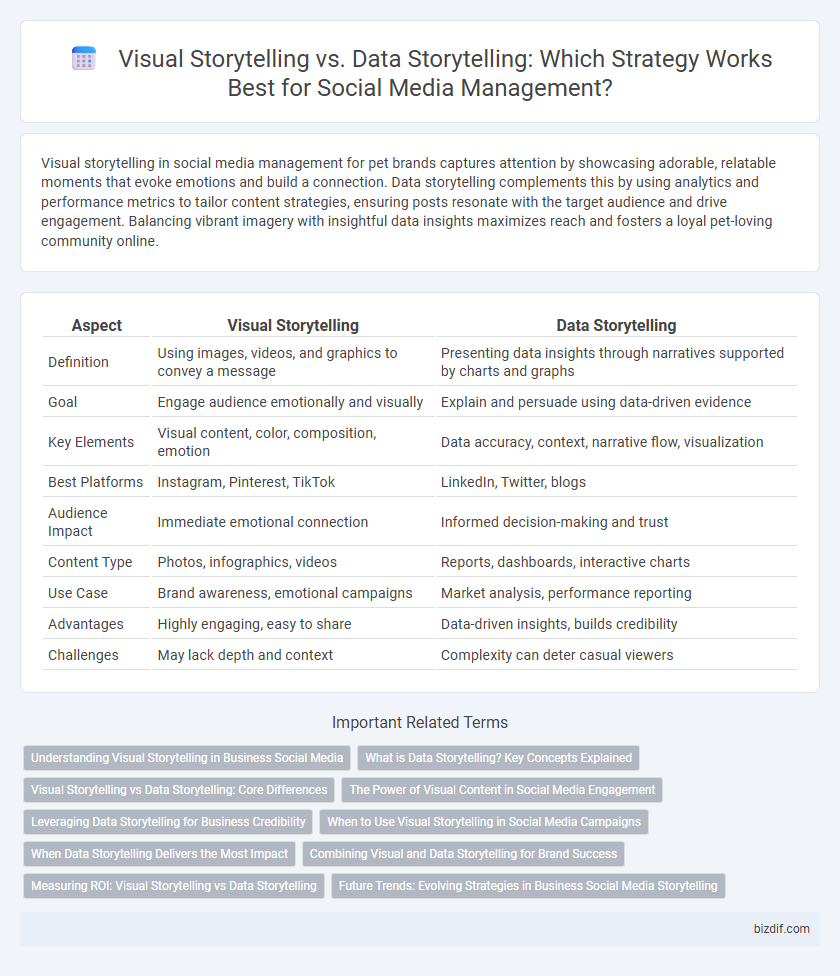Visual storytelling in social media management for pet brands captures attention by showcasing adorable, relatable moments that evoke emotions and build a connection. Data storytelling complements this by using analytics and performance metrics to tailor content strategies, ensuring posts resonate with the target audience and drive engagement. Balancing vibrant imagery with insightful data insights maximizes reach and fosters a loyal pet-loving community online.
Table of Comparison
| Aspect | Visual Storytelling | Data Storytelling |
|---|---|---|
| Definition | Using images, videos, and graphics to convey a message | Presenting data insights through narratives supported by charts and graphs |
| Goal | Engage audience emotionally and visually | Explain and persuade using data-driven evidence |
| Key Elements | Visual content, color, composition, emotion | Data accuracy, context, narrative flow, visualization |
| Best Platforms | Instagram, Pinterest, TikTok | LinkedIn, Twitter, blogs |
| Audience Impact | Immediate emotional connection | Informed decision-making and trust |
| Content Type | Photos, infographics, videos | Reports, dashboards, interactive charts |
| Use Case | Brand awareness, emotional campaigns | Market analysis, performance reporting |
| Advantages | Highly engaging, easy to share | Data-driven insights, builds credibility |
| Challenges | May lack depth and context | Complexity can deter casual viewers |
Understanding Visual Storytelling in Business Social Media
Visual storytelling in business social media leverages images, videos, and graphics to convey brand messages, evoke emotion, and enhance engagement more effectively than plain text. Brands using visual content see up to 80% higher retention rates and 94% more total views on platforms like Instagram and Facebook. Integrating compelling visuals with strategic narratives boosts audience connection, driving conversions and strengthening brand identity.
What is Data Storytelling? Key Concepts Explained
Data storytelling combines data visualization, narrative techniques, and context to communicate complex information clearly and persuasively in social media management. It transforms raw data into compelling stories that highlight key insights, trends, and patterns, making analytics accessible and actionable for audiences. Effective data storytelling leverages charts, graphs, and concise explanations to drive engagement and informed decision-making.
Visual Storytelling vs Data Storytelling: Core Differences
Visual storytelling uses imagery, video, and design elements to create emotional connections and convey messages quickly, making it ideal for capturing audience attention on platforms like Instagram and TikTok. Data storytelling, in contrast, relies on charts, graphs, and statistics to present insights and support decision-making, which is essential for analytics-driven social media reports and strategy development. The core difference lies in visual storytelling's focus on emotional engagement and narrative flow, while data storytelling emphasizes clarity, accuracy, and evidence-based communication.
The Power of Visual Content in Social Media Engagement
Visual content significantly boosts social media engagement by capturing users' attention through compelling images, videos, and infographics that convey messages quickly and emotionally. Visual storytelling enhances brand recall and encourages sharing, creating stronger audience connections compared to data storytelling, which relies on numbers and statistics for communication. Combining visual elements with concise data highlights optimizes content impact, driving higher interaction rates and fostering community growth across social platforms.
Leveraging Data Storytelling for Business Credibility
Leveraging data storytelling in social media management enhances business credibility by transforming complex analytics into clear, impactful narratives that resonate with audiences. Visual storytelling combined with data-driven insights fosters trust and authority, making brand messaging more persuasive and transparent. Integrating data visualization tools such as dashboards and infographics enables businesses to showcase performance metrics, customer trends, and ROI effectively.
When to Use Visual Storytelling in Social Media Campaigns
Visual storytelling excels in social media campaigns that aim to evoke emotional connections, increase brand engagement, and showcase product aesthetics through vibrant imagery or videos. It is most effective when targeting platforms like Instagram, TikTok, or Pinterest, where visual content drives higher user interaction rates. Employ visual storytelling to highlight customer experiences, brand values, or lifestyle narratives that resonate deeply with the audience.
When Data Storytelling Delivers the Most Impact
Data storytelling delivers the most impact in social media management when complex analytics and audience insights need to be communicated clearly to drive decision-making and strategy optimization. Visual storytelling excels in capturing attention and evoking emotions, but data storytelling transforms raw numbers into actionable narratives that highlight trends, measure campaign performance, and justify marketing investments. Leveraging interactive dashboards and infographics enhances the clarity and persuasiveness of data-driven social media campaigns.
Combining Visual and Data Storytelling for Brand Success
Combining visual storytelling and data storytelling enhances brand engagement by presenting complex information through compelling graphics and relatable narratives. Visual elements like infographics and videos capture audience attention while data storytelling provides credibility with evidence-based insights. This integrated approach drives emotional connections and informed decisions, maximizing social media impact and brand success.
Measuring ROI: Visual Storytelling vs Data Storytelling
Measuring ROI in social media management reveals distinct advantages between visual storytelling and data storytelling. Visual storytelling drives higher engagement rates and brand awareness, which translate into increased customer loyalty and conversions, while data storytelling provides precise metrics on campaign performance, enabling targeted strategy adjustments. Combining both approaches ensures comprehensive ROI analysis by capturing emotional impact and quantifiable results.
Future Trends: Evolving Strategies in Business Social Media Storytelling
Visual storytelling and data storytelling are converging as future trends in business social media strategies, with brands leveraging immersive visuals combined with data-driven insights to enhance engagement and credibility. Advances in AI-powered analytics and interactive content platforms enable marketers to deliver personalized narratives that resonate deeper with target audiences. Emerging technologies like augmented reality and real-time data visualization are set to redefine how stories are crafted and consumed, driving more interactive and impactful social media experiences.
Visual storytelling vs data storytelling Infographic

 bizdif.com
bizdif.com